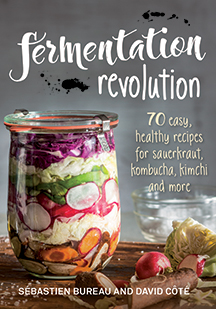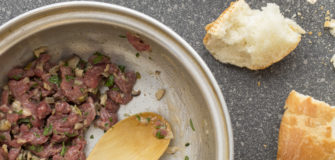Share
“Fermentation is one of the hottest kitchen trends of the past two years, and for good reason–it allows us to transform the ordinary into the extraordinary (think: delicious pickles, olives and ginger beer). But, more than that, fermented foods have enhanced nutritional value, aid in digestion and help regulate our immune systems.”
The following recipes are from Fermentation Revolution: 70 easy recipes for sauerkraut, kombucha, kimchi and more.

Almond Yogurt (Vegan or Not)
Equipment
- Large bowl, blender, eight 8-oz (250 mL) glass jars, yogurt maker or dehydrator or oven; optional: fine-mesh sieve, bowl, cheesecloth and airtight container
Ingredients
- 8 oz (250 g) raw almonds
- 8 oz (250 g) raw cashews (but don’t worry if they’re roasted
- 4 cups (1 L) water
- 2 cups (500 mL) filtered water
- 3 tbsp (45 mL) honey
- 1 tsp (5 mL) active cow milk yogurt or vegan yogurt, or 1 packet yogurt starter culture
- Pinch sea salt
Instructions
- In a large bowl, soak almonds and cashews in 4 cups (1 L) water for 8 hours. Drain nuts, then rinse with plenty of water.
- In blender, purée almonds and cashews, 2 cups (500 mL) filtered water and honey until thick and creamy. Add yogurt (or culturand salt, then blend for a few seconds.
- Pour into jars, leaving about 1 inch (2.5 cof space on top, and seal airtight. Place in a yogurt maker, dehydrator or any other incubator (for example, the oven of an electric range, with heat off but oven light oat 90°F to 104°F (32°C to 40°C). Let ferment for 6 to 8 hours.
- Taste and, if needed, let ferment awhile longer for more pronounced flavor.
- When yogurt is ready, shake jars to mix contents, then refrigerate.
- For thicker yogurt, place a fine-mesh sieve over a bowl and line it with several layers of cheesecloth. Transfer yogurt to sieve and refrigerate for a few hours, until liquid has drained. Transfer yogurt to an airtight container.
Notes
Tip: If using yogurt starter culture, use the whole packet unless the instructions on the packet say otherwise.
Classic Kimchi (Spicy Korean Sauerkraut)
“A meal without kimchi is not a meal,” says a Korean proverb. In Korea, it is rare to find a home where people don’t ferment their own kimchi, and family recipes are handed down from one generation to the next with great pride. There are as many variations on kimchi as there are homes in Korea. This version from our humble Montreal abodes has managed to win many hearts.”
Equipment
- Scale, fermentation jug or 2-gallon (8 L) pot, small plate (weight), large bowl, 2-quart (2 L) glass jar, airlock (optional)
Ingredients
- 2% Brine
- 6 tbsp + 2 tsp (100 g) sea salt
- 16 cups 4 L water, at room temperature
- 1 kg (2 lbs + 3 oz) Chinese cabbage (napa cabbage or giant bok choy)
- 7 oz (200 g) daikon radish or 13⁄4 oz (50 g) red radishes (about 5)
- 7 oz (200 g) carrot (1 large)
- 7 oz (200 g) yellow onion 1 medium, thinly sliced
- 2 cloves garlic minced
- 2 tsp 10 mL chopped gingerroot
- 1/4 cup (75 g) gochujang (Korean fermented chili paste) or 1 tbsp (15 mL) Korean hot chile peppers or other ground chile peppers
- 2 tbsp (30 g) sea salt (or the equivalent to 2% of total weight)
- 1 tbsp (15 mL) fish sauce or dried shrimp sauce (optional; see tip)
Instructions
- In a fermentation jug or large pot, prepare brine by dissolving salt in water. Submerge cabbage, daikon radish and whole carrot. Place a small plate on top as a weight.
- Let stand overnight (8 to 12 hours).
- Drain, discarding brine, and rinse cabbage, daikon radish and carrot. Slice cabbage into wide strips 3⁄4 to 11⁄4 inches (2 to 3 cm) long. Slice daikon and carrot into rounds or strips of 3⁄4 to 11⁄4 inches (2 to 3 cm )long. Place in a large bowl.
- Add onion, garlic, ginger, gochujang, salt and fish sauce (if using) to vegetables in bowl. Mix together.
- Press vegetables into the jar. Use the jar burping technique or an airlock.
- Let ferment for at least 3 days before tasting (kimchi is usually best after 3 to 4 days of fermentation). If mixture is ready, refrigerate in an airtight container. If not, continue to ferment, tasting every 2 days.
- Keeps for 1 year in the refrigerator.
Notes
Tip
Fish sauce or dried shrimp sauce will give your kimchi a more pronounced flavor. Kimchi purists will be able to tell that you’ve added this extra kick to the recipe, but we believe that kimchi is just as tasty without the added sauce.
Fish sauce or dried shrimp sauce will give your kimchi a more pronounced flavor. Kimchi purists will be able to tell that you’ve added this extra kick to the recipe, but we believe that kimchi is just as tasty without the added sauce.
Previous Article
Spiced Chocolate Molten Cake
Next Article
Tartare de cerf





